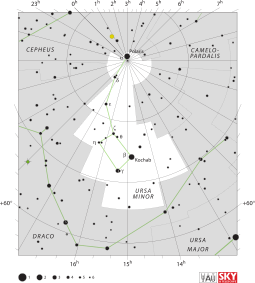Epsilon Ursae Minoris

| |
| Observation data Epoch J2000.0 Equinox J2000.0 | |
|---|---|
| Constellation | Ursa Minor |
| Right ascension | 16h 45m 58.1s |
| Declination | +82° 02' 14" |
| Apparent magnitude (V) | +4.21 |
| Distance | 303 ± 25 ly (92.9 ± 8 pc) |
| Spectral type | G5III |
| Other designations | |
Epsilon Ursae Minoris (ε UMi, ε Ursae Minoris) is a triple star system in the constellation Ursa Minor.[1] It is approximately 303 light years from Earth.[1]
The primary component, Epsilon Ursae Minoris A, is an eclipsing spectroscopic binary.[2] It is classified as a yellow G-type giant with a mean apparent magnitude of +4.21. In addition to light changes due to eclipses, the system is also classified as an RS Canum Venaticorum type variable star and its brightness varies from magnitude +4.19 to +4.23 with a period of 39.48 days, which is also the orbital period of the binary. The binary is orbited by a third component, Epsilon Ursae Minoris B, which is an 11th magnitude star,[2] 77 arcseconds away in the sky.
References
- 1 2 "Epsilon Ursae Minoris - Variable of RS CVn type". SIMBAD Astronomical Database. Centre de Données astronomiques de Strasbourg. Retrieved 21 June 2014.
- 1 2 Kaler, James B. "Epsilon Ursae Minoris". Stars. University of Illinois. Retrieved 21 June 2014.